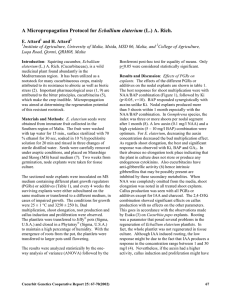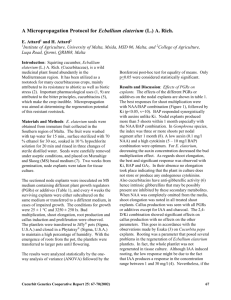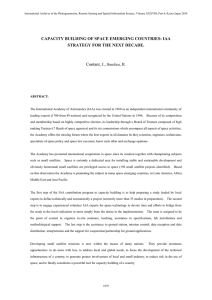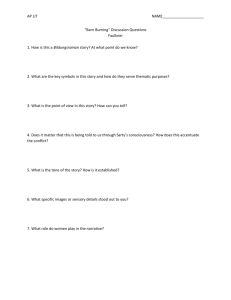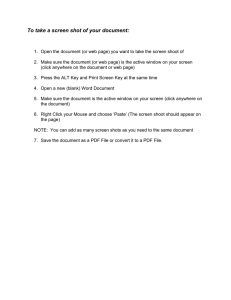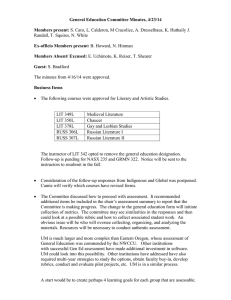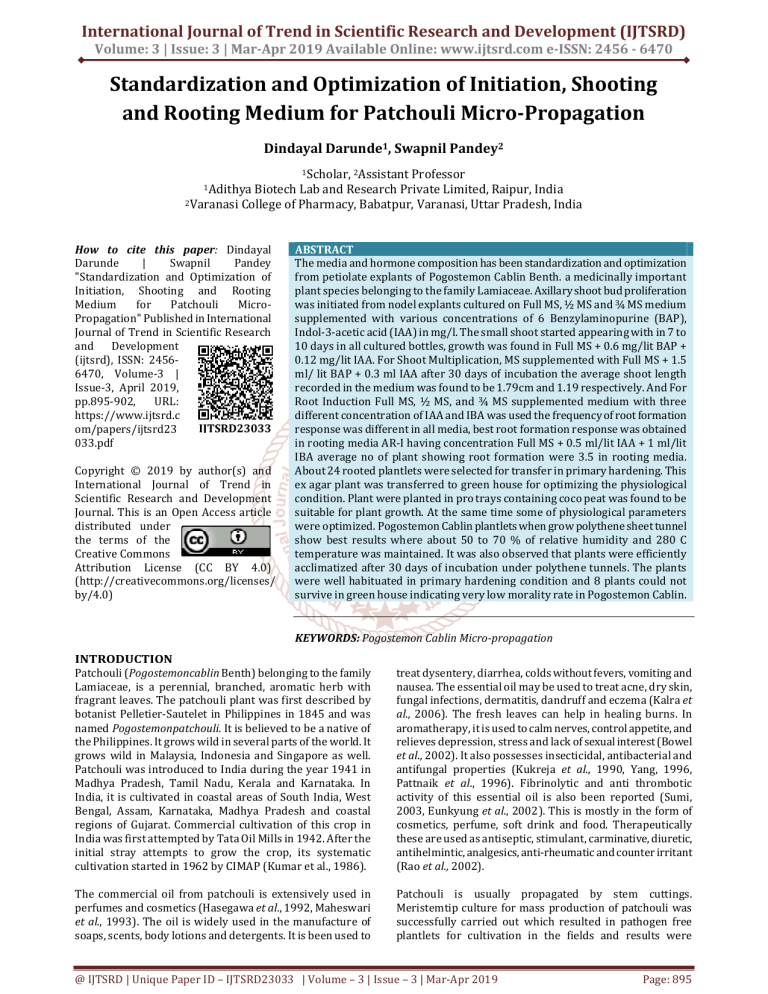
International Journal of Trend in Scientific Research and Development (IJTSRD)
Volume: 3 | Issue: 3 | Mar-Apr 2019 Available Online: www.ijtsrd.com e-ISSN: 2456 - 6470
Standardization and Optimization of Initiation, Shooting
and Rooting Medium for Patchouli Micro-Propagation
Dindayal Darunde1, Swapnil Pandey2
1Scholar, 2Assistant
Professor
Biotech Lab and Research Private Limited, Raipur, India
2Varanasi College of Pharmacy, Babatpur, Varanasi, Uttar Pradesh, India
1Adithya
How to cite this paper: Dindayal
Darunde
|
Swapnil
Pandey
"Standardization and Optimization of
Initiation, Shooting and Rooting
Medium
for
Patchouli
MicroPropagation" Published in International
Journal of Trend in Scientific Research
and
Development
(ijtsrd), ISSN: 24566470, Volume-3 |
Issue-3, April 2019,
pp.895-902,
URL:
https://www.ijtsrd.c
IJTSRD23033
om/papers/ijtsrd23
033.pdf
Copyright © 2019 by author(s) and
International Journal of Trend in
Scientific Research and Development
Journal. This is an Open Access article
distributed under
the terms of the
Creative Commons
Attribution License (CC BY 4.0)
(http://creativecommons.org/licenses/
by/4.0)
ABSTRACT
The media and hormone composition has been standardization and optimization
from petiolate explants of Pogostemon Cablin Benth. a medicinally important
plant species belonging to the family Lamiaceae. Axillary shoot bud proliferation
was initiated from nodel explants cultured on Full MS, ½ MS and ¾ MS medium
supplemented with various concentrations of 6 Benzylaminopurine (BAP),
Indol-3-acetic acid (IAA) in mg/l. The small shoot started appearing with in 7 to
10 days in all cultured bottles, growth was found in Full MS + 0.6 mg/lit BAP +
0.12 mg/lit IAA. For Shoot Multiplication, MS supplemented with Full MS + 1.5
ml/ lit BAP + 0.3 ml IAA after 30 days of incubation the average shoot length
recorded in the medium was found to be 1.79cm and 1.19 respectively. And For
Root Induction Full MS, ½ MS, and ¾ MS supplemented medium with three
different concentration of IAA and IBA was used the frequency of root formation
response was different in all media, best root formation response was obtained
in rooting media AR-I having concentration Full MS + 0.5 ml/lit IAA + 1 ml/lit
IBA average no of plant showing root formation were 3.5 in rooting media.
About 24 rooted plantlets were selected for transfer in primary hardening. This
ex agar plant was transferred to green house for optimizing the physiological
condition. Plant were planted in pro trays containing coco peat was found to be
suitable for plant growth. At the same time some of physiological parameters
were optimized. Pogostemon Cablin plantlets when grow polythene sheet tunnel
show best results where about 50 to 70 % of relative humidity and 280 C
temperature was maintained. It was also observed that plants were efficiently
acclimatized after 30 days of incubation under polythene tunnels. The plants
were well habituated in primary hardening condition and 8 plants could not
survive in green house indicating very low morality rate in Pogostemon Cablin.
KEYWORDS: Pogostemon Cablin Micro-propagation
INTRODUCTION
Patchouli (Pogostemoncablin Benth) belonging to the family
Lamiaceae, is a perennial, branched, aromatic herb with
fragrant leaves. The patchouli plant was first described by
botanist Pelletier-Sautelet in Philippines in 1845 and was
named Pogostemonpatchouli. It is believed to be a native of
the Philippines. It grows wild in several parts of the world. It
grows wild in Malaysia, Indonesia and Singapore as well.
Patchouli was introduced to India during the year 1941 in
Madhya Pradesh, Tamil Nadu, Kerala and Karnataka. In
India, it is cultivated in coastal areas of South India, West
Bengal, Assam, Karnataka, Madhya Pradesh and coastal
regions of Gujarat. Commercial cultivation of this crop in
India was first attempted by Tata Oil Mills in 1942. After the
initial stray attempts to grow the crop, its systematic
cultivation started in 1962 by CIMAP (Kumar et al., 1986).
treat dysentery, diarrhea, colds without fevers, vomiting and
nausea. The essential oil may be used to treat acne, dry skin,
fungal infections, dermatitis, dandruff and eczema (Kalra et
al., 2006). The fresh leaves can help in healing burns. In
aromatherapy, it is used to calm nerves, control appetite, and
relieves depression, stress and lack of sexual interest (Bowel
et al., 2002). It also possesses insecticidal, antibacterial and
antifungal properties (Kukreja et al., 1990, Yang, 1996,
Pattnaik et al., 1996). Fibrinolytic and anti thrombotic
activity of this essential oil is also been reported (Sumi,
2003, Eunkyung et al., 2002). This is mostly in the form of
cosmetics, perfume, soft drink and food. Therapeutically
these are used as antiseptic, stimulant, carminative, diuretic,
antihelmintic, analgesics, anti-rheumatic and counter irritant
(Rao et al., 2002).
The commercial oil from patchouli is extensively used in
perfumes and cosmetics (Hasegawa et al., 1992, Maheswari
et al., 1993). The oil is widely used in the manufacture of
soaps, scents, body lotions and detergents. It is been used to
Patchouli is usually propagated by stem cuttings.
Meristemtip culture for mass production of patchouli was
successfully carried out which resulted in pathogen free
plantlets for cultivation in the fields and results were
@ IJTSRD | Unique Paper ID – IJTSRD23033 | Volume – 3 | Issue – 3 | Mar-Apr 2019
Page: 895
International Journal of Trend in Scientific Research and Development (IJTSRD) @ www.ijtsrd.com eISSN: 2456-6470
promising with significant increases in leaf biomass and
essential oil yield. Clonal propagation and shoot meristem
culture were also reported in patchouli. Volkhovskaya
(1968) first reported rooting of patchouli leaves and
subsequent development of shoots. Selvarajan and Madhava
Rao (1981) reported only rooting but no shoot formation.
Vasantha Kumar and Narguda (1987) reported shoot
formation in leaf cuttings but subsequent growth was slow
and took 80-140 days for plantlet to reach optimum size
suitable for transplanting. Further, leaf with a portion of
petiole was used and shoot development occurred after
callus formation in the cut end of petiole. This resulted in
delayed shoot initiation and low success in plantlet
production.
The essential oils are usually complex mixture of terpenes
and their oxygenated derivatives. The essential oils are
practically insoluble in water, generally lighter than water,
and possess characteristic odour. But most cases evidence
for plant regeneration was restricted to only very few
explant types. There are also some reports on callus
induction and plant regeneration in patchouli (Mihsra, 1996;
Santos et al., 2011).some of this method gave a lot of little
shoots, but these might need for more time period to develop
plantlets. Hence, there is certainly a need for more research
to meet commercial-scale vegetative propagation of
patchouli. In the present study, the comparison of shoot
induction ability of different explants (leaf, nodal stem,
petiole, intermodal stem segment and root tip) was
conducted, and the effect of plant growth regulators (PGRs)
on shoot and root induction were studied. The study was to
establish a high frequency and rapid regeneration protocol
for patchouli.
Review of Literature
Patchouli plant was first described by Pelletier-Sautelet in
1845 and he was named as Pogostemon patchouli. In 1896,
Holmes identified it as P. cablin. The word cablin is derived
from ‘cabalam’ which is also a local name for the Patchouli in
the Philippines and these are synonymous (Bhaskar and
Vasantha Kumar, 2000). About 25 species of Pogostemon are
reported to occur in India. Patchouli is also known as
patchouly, tamalapatrain Sanskrit, patcholiin Hindi,
patchetenein Kannada, pacchilaiin Tamil, patchillain
Malayalam,
patchapanor
patchain
Marathi
and
guanghouxiangin Chinese.
The essential oil is used to treat acne, dry skin, fungal
infections, dermatitis, dandruff and eczema (Kalraet al.,
2006). The fresh leaves can be help in healing burns. In
aromatherapy, it is used to calm nerves, control appetite,
relieves depression, stress and lack of sexual interest (Bowel
et al., 2002). It has insecticidal, antibacterial and antifungal
properties (Kukreja et al., 1990, Yang, 1996, Pattnaik et al.,
1996).
Fibrinolytic and anti thrombotic activity of this essential oil
is also been reported (Sumi, 2003, Eunkyung et al.,
2002).This is mostly used in the form of cosmetics, perfume,
soft drink and food. Therapeutically it is used as antiseptic,
stimulant, carminative, diuretic, antihelmintic, analgesics,
anti-rheumatic and counter irritant (Rao et al., 2002).
Origin, wild relatives and distribution
Patchouli, a native of the Philippines, growing wild in many
South Asian countries is presently cultivated on a
commercial scale in India, Indonesia, Malaysia, China and
Singapore. Commercial cultivation of this crop in India was
first attempted by Tata Oil Mills in 1942. After initial stray
attempt to grow the crop, its systematic cultivation was
started in 1962 by CIMAP at its Regional Centre in Bangalore
(Anup Kumar et al., 1986). Subsequently, Patchouli has been
cultivated in some parts of India. Patchouli can be cultivated
in coastal regions of India as a main crop or as an intercrop
along with plantation crops. Patchouli, being a shade loving
plant can be easily grown as an intercrop amidst fruit trees,
arecanut and coconut plantations. It can also be easily
cultivated in flood free fallow. Patchouli is a hardy perennial
herb adapted to hot and humid climatic conditions and
found in South East Asia (Maheshwariet al., 1993).
Several varieties of Patchouli, both wild and cultivated
whose leaves and buds yield oils with Patchouli- like odour
are found growing in India, particularly in Western Ghats,
districts of Malabar, South Canara, Maharashtra, Madhya
Pradesh, Assam and West Bengal, where climatic conditions
are similar to those of Malaya and Sumatra (Menon, 1960). P.
heyneaus (Syn. P. Fleurissant Benth.) is indigenous to
Indiaand is cultivated in Java under the name ‘dilem’. In
commerce, it is popular as Javanese Patchouli or Dilem herb.
It resembles P. paniculatus growing near Malabar, Deccan
and Mumbai (Menon, 1960). P. plentranthoides Desf (Syn. P.
benghalensis) grows in Taraiand Bhadar forest division of
Uttar Pradesh. It is a large shrub growing mostly in shady
and moist places. Spikes are more than leaves and contain
more oil. It flowers profusely and the plant yields 0.25% oil
(Thapaet al., 1971).
Micropopagation
Micro-propagation (or in vitro propagation) is the most
common term this term used for clonal, true-to type
propagation of plants by variety of tissue, cell or organ
culture methods. Its implies of aseptic culture small sections
(explants) of tissue and organs, in closed vessels with
defined culture media and under controlled environment
condition micro propagation , in addition to genetic
engineering, is at present the most commercially efficient
and practically oriented plant biotechnology resulting in
rapid generation of large number of clonal plants.
Advantages of micro-propagation:Micro-propagation has a number of advantages over
traditional plants propagation techniques:
The main advantage of micro-propagation is the
production of many plants that are clones of each other.
Micro-propagation can be used to produce disease free
plants.
It is only viable method of regenerating genetically
modified cells or cells after protoplast fusion.
Rapid multiplication of genetically uniform plants that
posse’s desirable trait. Single explants can be multiplied
into many thousand plants in a very short time.
The production of multiplies of plants in the absence of
seeds or necessary pollinators to produce seeds.
The production of plants in sterile containers that allows
them to be moved with greatly reduced chances of
transmitting diseases, pests and pathogens.
Disadvantages of micro-propagation:
Micro-propagation is not always means of multiplying
plants. Conditions and limits are including:
It is very expensive, and can have a labour cost of more
than 70%.
@ IJTSRD | Unique Paper ID - IJTSRD23033 | Volume – 3 | Issue – 3 | Mar-Apr 2019
Page: 896
International Journal of Trend in Scientific Research and Development (IJTSRD) @ www.ijtsrd.com eISSN: 2456-6470
A monoculture is produced after micro-propagation,
leading to lack of overall disease resistance, as all
progeny plants may be vulnerable to the same
infections.
An infected plant sample can produce infected progeny.
Not all plants can be successfully tissue cultured, often
because proper medium for growth is not known or the
plant produce secondary metabolic chemicals that stunt
or kill the explants.
Sometimes plants or cultivars do not come true to type
after being tissue cultured. This is often dependent on
the type of explants material utilized during the
initiation phase or result of the cell or propagates line.
Some plants are very difficult to disinfect of fungal
organisms.
Media Components
Murashige and Skoog (1962) medium supplemented with
different phyto-hormones as per treatments were used as
culture medium for shoot induction, shoot multiplication and
maintenance and regeneration of roots from multiplied
shoot. Hormones were added separately to different media
according to the requirements. For the preparation of media,
stock solutions were prepared at the beginning and stored at
4°C temperature. The respective medium was prepared from
the stock solutions. And vitamins are also prepared and
stored in 4°C temperature. The conventional MS
macronutrients were used as a 3/4. Add BAP 100. The pH of
all the media was adjusted to 5.8 before adding gelling agent
agar. The media were sterilized at the temperature of 121ºC
for 20 minutes. After autoclaving, the culture medium is
stored in clean dust free chamber for 1-2 days before use in
order to check for any contamination. Bacterial
contamination may be observed, particularly during rainy
days. Use of ampicillin in the initiation and subsequent
cultures helps to prevent the latent bacterial contamination.
Growth Regulators
Some chemicals occurring naturally within plant tissues (i.e.,
endogenously) have a regulatory rather than a nutritional
role in growth and development. These compounds, which
are generally active at very low concentrations, are known as
plant hormones (or plant growth substances). We have
already considered of plasticity and totipotency. The
essential point as far as plant tissue culture is considered is
that, due to this plasticity and totipotency, specific media
manipulations can be used to direct development of plant
cells in culture. Plant growth regulators are the critical
media components in determining the developmental
pathway of the plant cells. The plant growth regulators used
most commonly are plant hormones or their synthetic
analogues.
There are two main classes of plant growth regulator used in
plant cell culture; Auxins and cytokinins are by far the most
important plant growth substances for regulating growth
and morphogenesis in plant tissue and organ cultures; in
these classes, synthetic regulators have been discovered
with a biological activity, which equals or exceeds that of the
equivalent natural growth substances
Auxins:-
Auxins promote both cell division and cell growth the most
important naturally occurring is IAA (indole -3-acetic acid),
but its use in plant cell culture media is limited because it is
unstable to both heat and light. Occasionally amino acid
conjugates of IAA, which are more stable, are used to
partially alleviate the problems associated with the use of
IAA. It is more common, though, to use stable chemical
analogues of IAA as a source auxin in plant cell culture
media. 2,4-Dichlorophenoxyacetic acid (2,4-D) is the most
commonly used auxin and is extremely effective in most
circumstances. α-naphthalene acetic acid (NAA), and indole3-butyric acid (IBA) are commonly used in the tissue
cultures. Indeed, all active auxins are weak organic acids.
The relative degree of activity of individual auxins in
different growth processes is very variable. It differs not only
from plant to plant but also from organ to organ, tissue to
tissue, cell to cell, and also with the age and physiological
state of the plant.
Cytokinins:-
Cytokinins promote cell division. Naturally occurring
cytokinins are a large group of structurally related
compounds. Of the naturally occurring cytokinins, two have
some use in plant tissue culture media. These are zeatin and
2ip(2- isopentyl adenine). Their use is not widespread as
they are expensive and relatively unstable. The synthetic
analogues, kinetin and BAP (benzylaminopurine), are
therefore used more frequently. Non-purine-based
chemicals, such as substituted phenylureas, are also used as
cytokinins in plant cell culture media. These substituted
phenylureas can also substitute for auxn in some culture
systems.
Cytokinins are N6-substituted adenines with growth
regulatory activity in plants that promote cell division and
may play a role in cell differentiation. Cytokinins added to
the medium are very important during tissue culture of
plants because they induce division and organogenesis and
affect other physiological and developmental processes.
The success of a culture is affected by the type and
concentration of applied cytokinins, because their uptake,
transport, and metabolism differ between varieties and they
can interact with endogenous cytokinins of an explants. The
correlation of auxins and cytokinins in the plants is a
constant (A/C=const.).
OBJECTIVES OF THIS STUDY
1. To standardization the media and hormone composition
for initiation of patchouli.
2. To development a suitable and reproducible protocol of
patchouli shooting and rooting.
PLAN OF WORK
1. Literature survey.
2. Selection of plant and species and explants for micro
propagation.
@ IJTSRD | Unique Paper ID - IJTSRD23033 | Volume – 3 | Issue – 3 | Mar-Apr 2019
Page: 897
International Journal of Trend in Scientific Research and Development (IJTSRD) @ www.ijtsrd.com eISSN: 2456-6470
3.
4.
5.
6.
7.
Standardization of media containing growth hormone.
Optimization and development of sterile condition for
media.
Development protocol and development of media.
Standardization of micro propagation.
Observations.
MATERIALS AND METHODS
Plant Materials
Nodal segments were procured from elite mother plants,
maintained at the mother plant nursery of Adithya Biotech
Lab and Research Pvt. Ltd., Raipur. All expanded leaves and
petioles were removed and the explants were cut into 1 - 2
cm length. The explants were washed 3 - 4 times in the tap
water and treated with liquid soap, teepol for 15 min
followed by thorough washing under tap water. These were
then surface sterilized with 0.5% HgCl2 for 10 min rinsing
was done five times with sterile distilled water to remove
traces of HgCl2 completely. Under aseptic conditions,
explants were inoculated on MS (Murashige and Skoog,
1962) medium, containing 2% (w/v) sucrose, supplemented
with different concentrations and combinations of BA (0.25,
0.5, 1.0 and 2.0 mg/L) proliferation and multiplication. The
pH of the medium was adjusted to 5.8 prior to the addition of
0.8% agar and autoclaved at 121°C, 15 lb pressure for 15
min.
Material
MS medium
Sodium hypochloride
Bovistin & antibiotic
Hgcl2
Distil water
Blade
METHODS
Methods
Micro-propagation is usually described as having the
following four distinct stages (a stage “0” is added by some
authors):
1. Stage “0”: preparation of in situ donor material
(fungicide and/or plant growth regulator)
2. Stage “I”: initiation (including surface sterilization) of
explants
3. Stage “II”: shoot multiplication (optimization of
proliferation media)
4. Stage “III”: root induction on micro-cuttings (in vitro or
ex vitro)
5. Stage “IV”: acclimatization of rooted shoots (or unrooted micro-cuttings)
1. Stage “0”: preparation of in situ donor material
(fungicide and/or plant growth regulator)
Fresh Nodal segments of patchouli were collected from the
orchard grown plants located in the field of Aditya Biotech
Lab and Research Pvt. Ltd., Raipur.
Selection of mother plant
Mother plant should be healthy, true to type and free
from diseases and pests, especially virus disease.
The male flower buds should be retained to check the
presence of virus diseases.
Mother plant should be raised under roofless insect
proof shade net with sufficient height.
Pedigree record and source of each mother plant should
maintain and catalogued.
2. Stage “I”: initiation (including surface sterilization)
of explants
Shoot cultures of patchouli start conventionally from any
part of plant that contains a shoot meristem, pseudo-stem,
small suckers, peepers and lateral buds. The apex of
inflorescence and auxiliary flower buds are also suitable
explants for tissue culture initiation.
For rapid in vitro multiplication of patchouli shoot tips from
young of 40-100 cm height are most commonly used as
explants. From the selected sucker a cube of tissue about 1-2
cm containing the apical meristem is excised. The tissue is
dipped in 70% ethanol for 10 sec surface sterilization in a
2% sodium hypocloride solution, and after second cutting
the sucker was dipped into the solution of 1% bovistin and
antibiotic [Ampicillin (500mg)] for 20 mints. And then the
sucker was washed two times in sterile distilled water, and
then dipped in the solution of 0.5% hgcl2 for 1hour. And
after 1 hour rinsed three times for 10 min in sterile water. It
is all the differ in explants type and size, disinfection
procedure, type of disinfectant and its concentration and
treatment duration. Subsequently shoot tip of about 3 to
5mm, consisting of the apical dome covered with several leaf
primordial and thin layer of corm tissue, is aseptically
dissected.
The optimal size of the explants depends on the purpose.
For rapid multiplication, relatively larger explants are
desirable despite its higher susceptibility to blackening and
contamination. When virus or bacteria elimination is needed,
meristem tip culture is the preferred option. The explant is
then further reduced in size (0.5-1 mm length), leaving a
meristematic dome with one or two leaf initials. Meristem
cultures have the disadvantage that they may have a higher
mortality rate and an initial slower growth.
The explant is placed directly on a multiplication-inducing
culture medium. For patchouli micro-propagation, MS-based
media are widely adopted. Generally, they are supplemented
with sucrose as a carbon source at a concentration of 30-40
g/l. Patchouli tissue cultures often suffer from excessive
blackening caused by oxidation of poly-phenol compounds
released from wounded tissues.
Therefore, during the first 4-6 weeks, fresh shoot-tips are
transferred to new medium every 1-2 weeks. Alternatively,
freshly initiated cultures can be kept in complete darkness
for one week. Antioxidants, such as ascorbic acid or citric
acid in concentrations ranging from 10-150 mg/l, are added
to the growth medium to reduce blackening, or the explants
are dipped in antioxidant solution prior to their transfer to
culture medium.
Usually two types of growth regulators, a cytokines and an
auxin, are added to the patchouli growth medium. Their
concentration and ratio determines the growth and
morphogenesis of the patchouli tissue.
In most patchouli micro-propagation systems, semi-solid
media are used. As a gelling agent agar is frequently added to
the culture medium but our preference is for Gel rite because
of its higher transparency, allowing much earlier detection of
microbial contamination.
Patchouli shoot-tip cultures are incubated at an optimal
growth temperature of 28 ± 2°C in a light cycle of 12-16 h
with a photosynthetic photon flux (PPF).
@ IJTSRD | Unique Paper ID - IJTSRD23033 | Volume – 3 | Issue – 3 | Mar-Apr 2019
Page: 898
International Journal of Trend in Scientific Research and Development (IJTSRD) @ www.ijtsrd.com eISSN: 2456-6470
3. Stage “II”: shoot multiplication (optimization of
proliferation media)
From the same culture, initiated shoots of uniform size, were
sub cultured into MS media. One explant was cultured in
each bottle, and take that explants and multiplication of the
shoots from the many steps. Shoots were sub culturing in 5
steps after 25 days. After 25 day the number of shoots
produced per explants.
The formation of multiple shoots and buds is promoted by
supplementing the medium with relatively high
concentrations of cytokines. For the multiplication of
propagules, we use the same medium as for the initiation of
shoot cultures (different concentrations of medium is
containing 1, 2, 3, 4mg/l BAP, 1 mg/l IAA and .4mg/l ADS). If
the production of highly proliferating meristem cultures is
required, higher concentration of BAP is added to the culture
medium. Higher concentrations of the cytokine BAP tend to
have an adverse effect on the multiplication rate and
morphology of the culture and should therefore be avoided.
The rate of multiplication depends both on the cytokines
concentration and the genotype. In general, shoot tips of
cultivars having only A genomes produce 2-4 new shoots,
whereas cultivars having one or two B genomes produce a
cluster of many shoots and buds at each subculture cycle.
Approximately 25-30 days after culture initiation, depending
on the initial explant size, new auxiliary and adventitious
shoots may arise directly from the shoot-tip explants.
4. Stage “III”: root induction on micro-cuttings (in vitro
or ex vitro)
Individual shoot or shoot clumps are transferred to a
nutrient medium which does not promote further shoot
proliferation but stimulates root formation. The cytokine in
the regeneration medium is greatly reduced or even
completely omitted. Within 2 weeks, shoot tips develop into
unrooted shoots. To initiate rhizogenesis NAA (anaphthalene acetic acid) or IBA (indole-3-butyric acid) are
commonly included in the medium at between 0.25, 1.0 and
2 mg/l. We use the same auxin concentration as in the
proliferation medium for IAA and IBA. For some genotypes
of patchouli that produce compact proliferating masses of
buds, activated charcoal (0.1-0.250%) is added to the
regeneration/rooting medium to enhance shoot elongation
and rooting. After rooting, plants are hardened in vitro for
some extra day’s incubation on the regeneration/rooting
medium prior to transplantation to soil.
5. Stage “IV”: acclimatization of rooted shoots (or unrooted micro-cuttings)
The in vitro regenerated plantlets with well-developed shoot
root and leaf systems were ready to shifting outside of the
laboratory. They are carefully acclimatised to adapt green
house and later to least protected field conditions. During
hardening the plantlets undergo physiological adaptation to
changing external factors like water, temperature, relative
humidity and nutrient supply. The plantlets from culture
vessels/bottles are moved from the laboratory. They are
shifted to green house for primary hardening.
RESULT AND DISCUSSTION
The tissue culture was done through explants as auxiliary
bud after 1 month of initiation newly shoot had been
generated. Shoot had be re-cultured and transferred to
multimedia, thereby transferred to green house.
Initiation of Explants
Auxiliary buds from mother plant were used as explants for
in vitro regeneration .the explants cutted into desired shape
and size with different concentration of BAP and IAA for
initiation and establishment small shoot started appearing
with in 7 to 10 days in all cultured bottles, growth was found
in Full MS + 0.6 mg/lit BAP + 0.12 mg/lit IAA. The
observation and result obtained in the study and discuss in
this section.
Media
type
Media
composition
Initial
height of
explants
(avg)
No of
leaves
after 7
days (avg)
AI-I
Full MS + 0.6
ml/lit BAP +
0.12 ml/lit IAA
1.3
4
AI-II
½ MS + 0.3
ml/lit BAP +
0.6 ml/lit IAA
1.5
2
¾ MS + 0.2
ml/lit BAP +
1.1
1
0.4 ml/lit IAA
Table no 1: Effect of different concentration of BAP and
IAA in combination for initiation
AI-III
For Shoot Multiplication
For recording average no of no of multiple shoot and shoot
elongation randomly 10 bottles were selected for periodic
observation and documentation through 2 sub cultured of
Pogostemon cablin, It was observed in AM-I medium i.e. MS
supplemented with Full MS + 1.5 ml/ lit BAP + 0.3 ml IAA
after 30 days of incubation the average shoot length
recorded in the medium was found to be 1.79cm and 1.19
respectively. Whereas minimum shoot length of 0.89 cm was
observed in media AM-III supplemented with ¾ MS + 0.1
ml/ lit + 0.2 ml/lit IAA. The observation and result obtained
in the study and discuss in this section.
Media
type
Media
composition
(avg)
no of
shoots
(avg)
height of
shoots
(avg)no
leaves
AM-I
Full MS + 1.5
ml/ lit BAP +
0.3 ml IAA
4.2
1.79
45.2
AM-II
½ MS + 0.75
ml/lit BAP +
0.15 ml IAA
2.4
1.19
42
¾ MS + 0.1
ml/ lit + 0.2
1.4
0.89
31.4
ml/lit IAA
Table no 2: Effect of different concentration of BAP and
IAA in combination in shoot multiplication
AM-III
Survival Percentage
The percentage of survival varied between shooting media
carrying different levels of BAP. The maximum survival rate
was found in the medium containing 1.5 ml/ lit BAP and 0.3
ml IAA on which shoot active and healthy were compared to
other treatments. The survival percentage found in
multiplication of shoot was found to be 65 %. It was
observed that survival percentage increased with number of
sub culturing.
@ IJTSRD | Unique Paper ID - IJTSRD23033 | Volume – 3 | Issue – 3 | Mar-Apr 2019
Page: 899
International Journal of Trend in Scientific Research and Development (IJTSRD) @ www.ijtsrd.com eISSN: 2456-6470
For Root Induction
The regenerated shoots were used for root induction in root
forming media AR-I, AR-II, AR-III. Full, half, and ¾ MS
supplemented with three different concentration of IAA and
IBA was used the frequency of root formation response was
different in all media, best root formation response was
obtained in rooting media AR-I having concentration Full MS
+ 0.5 ml/lit IAA + 1 ml/lit IBA average no of plant showing
root formation were 3.5 in rooting media where as AR-II and
AR-III respectively. The frequency of root formation was
recorded best in AR-I heavy healthy roots more than 3 roots
per plant and whitish colour. Growth was found in Full MS +
0.5 ml/lit IAA + 1ml/lit IBA. The observation and result
obtained in the study and discuss in this section.
Media
type
Media
composition
No. of plants
showing roots
(mean value)
Avgas
height of
shoots
Full MS + 0.5
ml/lit IAA + 1
3.5
2.1
ml/lit IBA
½ MS + 0.25
AR-II
ml/lit IAA +
2.2
1.89
0.5 ml/lit IBA
¾ MS + 0.33
AR-III
ml/lit IAA +
1.45
0.9
0.66 ml/lit IBA
Table no 3: Effect of different concentration of IBA and IAA
on Root induction
AR-I
Hardening
About 24 rooted plantlets were selected for transfer in
primary hardening. This ex agar plant was transferred to
green house for optimizing the physiological condition. Plant
were planted in pro trays containing coco peat was found to
be suitable for plant growth. At the same time some of
physiological parameters were optimized. Pogostemon
Cablin plantlets when grow polythene sheet tunnel show
best results where about 50 to 70 % of relative humidity and
280 C temperature was maintained. It was also observed that
plants were efficiently acclimatized after 30 days of
incubation under polythene tunnels. The plants were well
habituated in primary hardening condition and 8 plants
could not survive in green house indicating very low
morality rate in Pogostemon Cablin.
Figure2. Culture initiation of MS media AI-I
Figure3. Multiplication of shoot in AM-I
Figure1. Auxiliary bud used as explants
Figure4. Elongation of shoot AM-I
@ IJTSRD | Unique Paper ID - IJTSRD23033 | Volume – 3 | Issue – 3 | Mar-Apr 2019
Page: 900
International Journal of Trend in Scientific Research and Development (IJTSRD) @ www.ijtsrd.com eISSN: 2456-6470
Figure5. Rooting induction media AR-I for elongated
shoots
Figure6. During washing of plantlets
CONCLUSION
The present study was carried out to “Standardization and
Optimization of Initiation, Shooting and Rooting medium
were the major objective of the study. Media containing BAP
Full MS + 0.6 ml/lit BAP + 0.12 ml/lit IAA in MS medium was
found most suitable for initiation. For shoot proliferation &
multiplication AM-I media i.e. MS supplemented with Full MS
+ 1.5 ml/ lit BAP + 0.3 ml IAA was found to be best while for
root induction AR-I i.e. MS supplemented with Full MS + 0.5
ml/lit IAA + 1 ml/lit IBA. In rooting stage three different
combinations of IAA and IBA in % strength MS medium were
tested and the AR-I media (VS strength MS media
supplemented with 0.5 ml/lit IAA and1 ml/lit IBA) showed
optimum root formation and development. From the present
study it can be concluded that MS media supplemented with
Full MS + 0.6 ml/lit BAP + 0.12 ml/lit IAA is best for
initiation. For shoot proliferation & multiplication strength
MS media supplemented with Full MS + 1.5 ml/ lit BAP + 0.3
ml IAA is best. while root induction strength of MS media
supplemented with Full MS + 0.5 ml/lit IAA + 1 ml/lit IBA.
SUMMARY
The present study on Standardization and Optimization of
Initiation, Shooting and Rooting Medium for patchouli Micropropagation through plant tissue culture- was conducted at
Adhitya Biotech Agricon Research and Development Centre,
Nandanvan Road Raipur (C.G.). The main objective of plant
tissue culture of patchouli was to standardize protocol for
initiation, mass multiplication and root induction of
Pogostemon Cablin. Healthy explants were taken from the
selected elite mother plants from the Pogostemon Cablin field
and dipped in the 2% Sodium hypochloride solution. The
explants were excised into optimum shape and size (1.7-2.1)
and treated with 1 % bovistin solution for 20 minutes
followed by treatment with 0.2 % HgCL2 for 10 minutes.
The initiation of micro-propagation of Pogostemon Cablin
encircles media preparation which includes MS medium
containing concentration of Full MS + 0.6 ml/lit BAP + 0.12
ml/lit IAA after inoculation to the media, incubated at 25°C
and 30% relative humidity. The culture was incubated for
one month and for the multiplication of shoots on the media
viz. AM-I, AM-II and AM-III containing BAP and IAA. With
depletion of nutrients the inoculums need to be sub-cultured
into the fresh media.
Figure7. After washing of plantlets
After second to third fourth sub- culture, culture was
induced for root induction. Regenerated shoots were
transferred to the rooting media containing three different
combination of IBA, and IAA. Culture was incubated in same
conditions as in initiation for 1 month for the rooting of
shoots on the media viz.AR-I, AR-II,AR-III Incubation period
for rooting was 1 month at 25°C0 temperature after rooting
the plantlets were transferred to primary hardening which
was allowed to adapt gradually to the external environment.
Refrences:[1] Bharati N (2002). Biotechnology in commercial
production of patchouli in NE region. In : Patchouli.
NationalWorkshop on Commercialization of patchouli
in NE region dated 9-11 April, 2002 at Guwhati, Assam
organized by NEDFC and NHB, pp:46-51.
[2] Bowel EJ, Griffiths DM, Quirk L, Brownriggs A, Croot
(2002). Effect of essentials oils and touch on resistance
to nursing care procedures and other dementia related
Figure8. Primary hardening of plantlets
@ IJTSRD | Unique Paper ID - IJTSRD23033 | Volume – 3 | Issue – 3 | Mar-Apr 2019
Page: 901
International Journal of Trend in Scientific Research and Development (IJTSRD) @ www.ijtsrd.com eISSN: 2456-6470
behaviours in a residential care facility. Int. J.
Aromather. 12: 22-29
[3] Hasegwa Y, Tajima K, Toli N, Sugimura Y (1992).An
additional constituent occurring in the oil from a
patchouli cultivar. Flav. Fragr.J.7:333-335
[4] Kukreja AK, MathurAK, Zaim M (1990). Mass
production of virus free patchouli plants
[Pogostemoncablin (Blanco) Benth.] by in vitro culture.
Trop.Agrc.67: 101-104.
[5] Kumaraswamy M, Balasubramanya S, Anuradha M
(2010).
Invitro
multiplication
of
PogostemoncablinBenth.
Through
direct
organogenesis. Afr J Biotechnol 9 (14) : 2069-2075
[6] Maheswari , ML, Vasantha Kumar T, Neelam Sharma
and Chandel KPS (1993). Patchouli- An Indian
perspective. Indian perfumer, 37:9-11.
[7] Meena M (1996). Regeneration of patchouli
cablinBenth.)plants from leaf and node callus and
evaluation after growth in the field. Plant cell Rep.,
15:991-994.
[8] Misra M (1996). Regeneration of Patchouli
(PogostemoncablinBenth.) plants from leaf node callus
and evaluation after growth in the field. Plant cell Rep.
15:991-994.
[9] Rajan GB, Shakila A, Rajasekaran LR (1997). Mass
peopagation of Pogostemon patchouli through somatic
embryogenesis. South Indian Hort. 45: 45-49.
[10] Redenbaugh K, Slade P, Viss PR, Fugii JA
(1987).Encapsulation of a somatic embryos in
synthetic seed coats. Hort. Sci., 22: 803-809.
[11] Sharma D, Naik PS (1998). Sunseeds in potato: an
investigation using nutrient encapsulated in vitro
nodal segments. Sci. Hortic. 73:179-184.
[12] Straus J (1960). Development of a synthetic medium.
Am.J.Bot.,47: 641-646
[13] Sumi H [2003]. Fibrinolysis- accelerating activity of the
essential oils and Shochu aroma. Aroma Res. 4 (3):
264-267.
[14] Vijayakumar, K.2004. Patchouli and India A great leap
forward. In: National Seminar of prospectus and
potentials of Medicinal and aromatic crops, held at
Bangalore, 18-19 June 2004, pp.106-107.
[15] Yang D (1996). Michel, Mandinandriamboavonjy,
Poitry, Chaumont, Mellet C Antifungal and antibacterial
properties in vitro of three patchouli oils from different
origins. Acta Botanica. Gallica. 143 91):29-35.
@ IJTSRD | Unique Paper ID - IJTSRD23033 | Volume – 3 | Issue – 3 | Mar-Apr 2019
Page: 902

